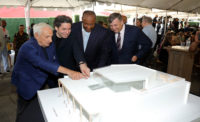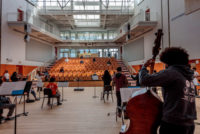
The Frank Gehry-designed Winton Guest House—which was moved 110 miles from its original Minnesota site barely five years ago—sold at auction May 19th with the condition that the new owners must transplant it yet again.
After just four bids at Wright’s auction house, the hammer came down at $750,000, setting the final sale price (which includes an additional transaction fee) at $905,000.
While that figure falls short of the $1-to-$1.5 million expected—and well below the house’s appraised 2008 value of $4.5 million—the price recognizes the significant cost of a move. And, as it turns out, the 2,300-square-foot home faces an ambitious journey ahead: from Owatonna, Minnesota to upstate New York. The buyers (or buyer), who phoned in the winning bid, have not chosen to reveal their identity publicly, but, according to Wright president Richard Wright, “They will allow us to say that the structure will be used as part of a private home in the Hudson Valley and that their intentions are to oversee its restoration and preservation into the future.”
Professor Victoria Young, who represented the seller, the University of St. Thomas, where she chairs the art history department, says, “This was very good news because my biggest concern was that the house go to someone who’d recognize and honor its significance.”
Although Gehry built the guesthouse in 1987 for a couple, Mike and Penny Winton, the university became its owner 20 years later, after developer Kirt Woodhouse bought and subdivided the property, in Wayzata, Minnesota, along Lake Minnetonka [Record, February 2008]. Given Wayzata’s high land values, the guest pavilion—ancillary to the main house by Philip Johnson—was too small for a stand-alone home. But Woodhouse ultimately saved the Gehry work by donating it, along with moving expenses, to the University of St. Thomas (UST), which re-erected it on its secondary campus, a conference and retreat center in Owatonna, Minnesota.
As a cluster of discrete geometric volumes, the guesthouse lent itself to division into eight sections for transfer by Stubbs Building Movers. The process, involving extensive pre- and post-move logistics and construction, took about two years, with estimated costs nearing $1 million. But barely three years later, in 2014, UST sold the Owatonna campus, with a stipulation that it would move the guesthouse within two years.
Though professor Young had hoped it would go to St. Thomas’s main campus, in St. Paul—providing a publicly accessible landmark and learning resource—she was instrumental in achieving her second-choice outcome: a successful sale to a committed party.
“There was a great deal of pre-auction interest,” says Wright, who previously auctioned off such masterworks as Pierre Koenig’s Case Study House #21 and Louis Kahn’s Esherick House. Leading up the Winton’s auction, Young showed it to many prospective buyers—even attempting to bring it to the attention of actor and architecture aficionado Brad Pitt.
The house’s relocation will inevitably involve vetting the entire route—at least 1,200 miles—for power lines, bridge crossings, and other clearance issues, as site preparation is underway. The building must be off the Owatonna campus no later than August 2016. And though its future appears promising, we have a hunch the Winton Guesthouse won’t become a “Brangelina” hideaway, after all.



Post a comment to this article
Report Abusive Comment